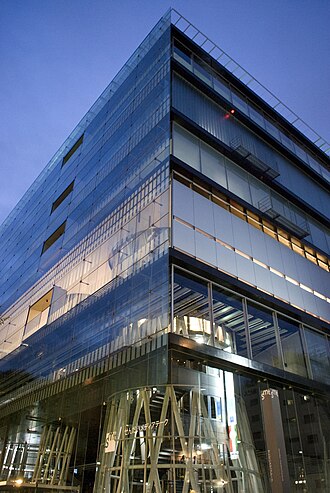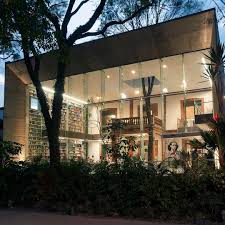Usos culturales en arquitectura: bibliotecas singulares / Cultural uses in architecture: unique libraries
El desarrollo de un país o región se puede medir por diversos factores. Sin duda, creemos que el nivel intelectual (siendo prácticamente el mayor diferenciador con respecto al resto del mundo animal) es clave en este tema. Hoy, queremos analizar algunos edificios o espacios dedicados al albergue y uso del libro, las bibliotecas, teniendo en cuenta que han mostrado al mundo el desarrollo tecnológico y académico local, o incluso han servido como herramientas para fomentar o potenciar este desarrollo de las ideas y proyectos.
The development of a country or region can be measured by various factors. Without a doubt, we believe that intellectual level (being practically the greatest differentiator with respect to the rest of the animal world) is key in this regard. Today, we want to analyze some buildings or spaces dedicated to the housing and use of books, libraries, considering that they have demonstrated local technological and academic development to the world, or have even served as tools to foster or enhance the development of ideas and projects.
1. MEDIATECA DE SENDAI / SENDAI MEDIA LIBRARY

(Vista oblicua del exterior de la Mediateca de Senadi. Oblique view of the exterior of the Sendai Media Library.)
Este complejo no solo incluye biblioteca, sino también una galería de arte, un teatro de proyecciones visuales y centro de información para personas con discapacidad. Pero lo podemos considerar todo un referente en cuanto a albergue de sabiduría y cultura, con una biblioteca de lo más prolífera.
Arquitectónicamente, es un hito dentro de una de las principales avenidas de la ciudad de Sendai, tanto por su presencia, como por lo que supone a nivel artístico y cultural. Situada en el centro de un lado de una manzana, luce transparente a la vez que imponente, con una tecnología de vanguardia que pocos edificios tienen. Forma parte de la máxima expresión del avance del desarrollo tecnológico aplicado a los espacios de uso cotidiano, de uso público. en la ciudad japonesa de Sendai.
Es un edificio que no sólo está hecho para albergar libros y personas, sino para adaptarse a las necesidades tecnológicas, electrónicas y de la información que imperan en la actualidad. El edificio no solo está compuesto desde la estructura y solidez, sino desde la complejidad de los cuerpos de los seres vivos, órganos, instalaciones, señales neurológicas... Son conceptos aplicados a una arquitectura comprometida con su sociedad, y donde los tubos verticales transparentes de acero no solo sostienen toneladas de cargas estructurales, sino que son transmisores de valiosa información por su interior.
Una piel que transpira, que mira al exterior y se deja ver, una cubierta capaz de controlar la luz que el cuerpo necesita introducir en su interior para funcionar y ser eficiente. Podemos decir que nuestros libros, el saber, está bien albergado; y que la información que se guarda, transmite y enseña en este complejo, funciona con fluidez, transparencia y velocidad; cualidades requeridas por los seres humanos en la actualidad.
This complex not only includes a library, but also an art gallery, a visual projection theater, and an information center for people with disabilities. However, we can consider it a benchmark as a haven of knowledge and culture, with a very extensive library.
Architecturally, it is a landmark on one of Sendai's main avenues, both for its presence and for its artistic and cultural significance. Located in the center of one side of a block, it appears transparent yet imposing, boasting cutting-edge technology that few buildings possess. It is one of the finest examples of technological advancement applied to everyday, public spaces in the Japanese city of Sendai.
It's a building not only designed to house books and people, but also to adapt to today's prevailing technological, electronic, and information needs. The building is not only composed of structure and solidity, but also of the complexity of living beings' bodies, organs, installations, neurological signals... These are concepts applied to an architecture committed to its society, where the transparent vertical steel tubes not only support tons of structural loads, but also transmit valuable information throughout their interior.
A skin that breathes, that looks outward and allows itself to be seen, a covering capable of controlling the light that the body needs to bring inside to function and be efficient. We can say that our books, our knowledge, are well housed; and that the information stored, transmitted, and taught in this complex works with fluidity, transparency, and speed—qualities required by human beings today.
2. CENTRO CULTURAL ELENA GARRO (MÉXICO) / SENDAI MEDIA LIBRARY(MEXICO)

Destacamos, además de la belleza formal y de diseño, cómo un edificio o uso que podría ser destinado a lugares urbanos más representativos o expuestos, es implantado con tanta modestia, en un lugar sereno, además de manteniendo la escala de una antigua vivienda, en altura, volumen e incluso tratamiento material. Por otro lado, la vegetación se torna un elemento fundamental, teniendo mucha presencia no solo en el exterior, sino también en el interior (varios árboles en la sala principal "perforan" el techo). El forjado con cierta inclinación, salvando la diferencia de cota de niveles, y los mezzanines en la doble altura de la antesala principal, son elementos que dotan de fluidez y apertura al espacio.
According to the project report by the authors (on their website): "The project, located in Coyoacán, consists of an adaptation of an existing mansion - a listed building from the early 20th century - to be transformed into a Cultural Center on Fernández Leal Street. The need to preserve the existing building led to the decision that the project should highlight the new uses while respecting the original shell. Thus, the project consists of several elements that define the intervention: a first piece that marks the access, as if it were a kind of frame, linking the work with the street and highlighting the existing mansion; a series of gardens and patios that surround the project and are inserted within; and a rectangular volume towards the back of the lot, developed on three floors, made up of a multipurpose room, storage rooms, services and parking on the ground floor. These pieces mark the different routes and manage to unite the different parts of the complex."
We highlight, in addition to the formal and design beauty, how a building or use that could be destined for more representative or exposed urban locations is implemented with such modesty in a serene location, while maintaining the scale of an old house, in height, volume, and even material treatment. Furthermore, vegetation becomes a fundamental element, prominent not only in the exterior but also in the interior (several trees in the main hall "pierce" the ceiling). The slightly inclined slab, bridging the difference in elevation between levels, and the mezzanines in the double-height main entrance hall are elements that provide fluidity and openness to the space.
3. BIBLIOTECA DE VIPURI (FINLANDIA) / VIPURI LIBRARY (FINLAND)
Se trata de una de las obras más estudiadas en las escuelas de arquitectura, del prestigioso arquitecto finlandés del siglo XX Alvaar Aalto. Condicionada por la relación del gobierno finlandés con el ruso, al que cedió la ciudad mediante un tratado después de la Guerra de Invierno de 1939-40., para después recuperarlo tras la Segunda Guerra Mundial. Ya en el siglo XX, con una mayor diplomacia entre los gobiernos actuales, surgió la idea de restaurar el edificio, que pone en valor aquellos elementos, sobre todos interiores, que Alvar Aalto con tanta singularidad expresaba.
Pese a la aparente sencillez de la planta (dos rectángulos regulares desplazados entre sí), la sección se muestra mucho más compleja, con diferentes niveles interconectados, tal y como ocurre, con la diferencia de ambas escalas, en el Centro Cultural anterior (apartado 2). Se dota así de gran fluidez y naturalidad al espacio, en esa metáfora siempre presente en los proyectos de Aalto (simula el río, la aurora boreal, el bosque), algo complejo de conseguir teniendo en cuenta el racionalismo y técnica del Movimiento Moderno y su estilo artístico.
Empleando sin ninguna duda elementos del Movimiento Moderno (formas puras, colores básicos, expresionismo estructural o sobriedad ornamental), aprovecha los espacios "residuales" o extremos para darles un sentido, en ese gesto que tanto destaca en la "buena arquitectura", y que denota calidad. Las estanterías colmatan algunos de estos espacios, y los rellanos son verdaderos espacios acogedores de lectura. Con el objetivo de llenar las salas de lectura con luz difusa, inventó un lucernario cónico que permitía el paso de la luz del día evitando la entrada de rayos solares directos que produjeran sombras o deslumbramiento. Apoyándose en la rejilla generativa que organiza las salas de lectura, creó huecos en el techo de dos metros de dimensión, dando al techo un aspecto futurista.
En este apartado hemos podido ver cómo en la arquitectura de los espacios culturales todo es posible, en una edificación caracterizada por el movimiento y dinamismo, sacudida por el movimiento de las guerras, pero con la fuerza de la voluntad de restaurarla, y con espacios que invitan a la lectura y serenidad, con una iluminación natural adaptada a estar junto a libros.
CONCLUSIÓN
Tras estos tres casos de arquitectura cultural, hemos podido ver las condiciones tan diferentes que experimentaron, lo cual demuestra la diversidad a la que se expone la arquitectura en general, y las bibliotecas en particular.
This is one of the most studied works in architecture schools by the prestigious 20th-century Finnish architect Alvar Aalto. It was influenced by the Finnish government's relationship with Russia, to which the city was ceded by a treaty after the Winter War of 1939-40, only to be recovered after World War II. Already in the 20th century, with greater diplomacy between the current governments, the idea of restoring the building emerged, highlighting those elements, especially the interior ones, that Alvar Aalto expressed with such singularity.
Despite the apparent simplicity of the plan (two regular rectangles offset from each other), the section appears much more complex, with different interconnected levels, just as, with the difference in both scales, in the previous Cultural Center (section 2). This gives the space great fluidity and naturalness, in that metaphor ever present in Aalto's projects (simulating the river, the northern lights, the forest), something difficult to achieve considering the rationalism and technique of the Modern Movement and his artistic style.
Undoubtedly employing elements of the Modern Movement (pure forms, basic colors, structural expressionism, and ornamental sobriety), he takes advantage of "residual" or extreme spaces to give them meaning, in that gesture so prominent in "good architecture" and which denotes quality. Bookshelves fill some of these spaces, and the landings are truly welcoming reading spaces. With the aim of filling the reading rooms with diffused light, he invented a conical skylight that allowed daylight to pass through while avoiding the entry of direct sunlight that would produce shadows or glare. Based on the generative grid that organizes the reading rooms, he created two-meter-wide openings in the ceiling, giving it a futuristic appearance.
In this section, we have seen how everything is possible in the architecture of cultural spaces, in a building characterized by movement and dynamism, shaken by the upheavals of war, but with the strength of the will to restore it, and with spaces that invite reading and serenity, with natural lighting adapted to be next to books.
CONCLUSION
Through these three cases of cultural architecture, we have been able to see the very different conditions they experienced, which demonstrates the diversity to which architecture in general, and libraries in particular, are exposed.